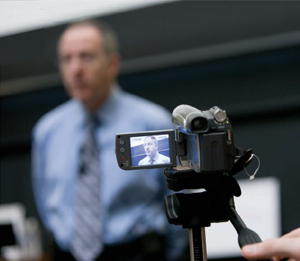After thirty years as a faculty member and, more recently, university administrator, I have learned that communication is an ever-changing challenge, whether with colleagues on campus, parents, trustees, state and federal officials, or others. But no challenge is more interesting than staying in touch with and responding to the thoughtful feedback I get from Cornell's quarter-million living alumni. They span six continents, 100-plus countries, all of the U.S. states, and some eighty-five years of Cornell history.
Cornell's ability to connect with its far-flung and multifaceted alumni body is critical to the future of our university. Traditional programs—class and club initiatives, university council, college advisory councils, special program councils—help us all stay in touch. More recent programs like Cornell Silicon Valley, Cornell Entrepreneur Network, and Cornell Wall Street bring together alumni around professional interests. And now the rocketing development of the Internet and social media offers us many more opportunities, so I'm learning about exciting ways to stay in even closer touch. My teachers? Current and recent students, Internet-savvy alumni, the professionals in University Communications, faculty and staff, and, most recently, the professionals in our Office of Alumni Affairs, where three new senior directors under the leadership of Associate Vice President Chris Marshall are strengthening Cornell's ability to connect with our alumni.
Tim Mahar, senior director of affinity programs, oversees our regional programs and is developing a new affinity program to connect Cornellians around the activities they enjoyed as undergraduates. Laura Denbow, senior director of volunteer programs, is finding ways to better match volunteers with opportunities to participate and serve—including a "career path" to enable volunteers to grow into ever more satisfying roles. And Andrew Gossen, senior director of social media, is taking on the newest challenge: how to use the latest Internet technology in our alumni communications.
As Andrew notes, "In the old days, alumni were dependent on the alumni office because the alumni office had the alumni database—no large-scale interaction was possible without it. Now, in a Web 2.0 world, alumni have the tools to organize themselves and engage each other in the name of and about their alma mater without assistance or permission from anyone."
 Facebook and LinkedIn are two obvious resources for Cornell to use, as is CornellConnect—which is described as "part online directory, part social network" just for Cornellians. Andrew has also been working with the Cornell Entrepreneur Network and the company RippleFly to improve the effectiveness of networking at events by letting those registered know of other attendees with similar interests.
Facebook and LinkedIn are two obvious resources for Cornell to use, as is CornellConnect—which is described as "part online directory, part social network" just for Cornellians. Andrew has also been working with the Cornell Entrepreneur Network and the company RippleFly to improve the effectiveness of networking at events by letting those registered know of other attendees with similar interests.
Even I have begun to use these new media. I have greatly enjoyed my foray into the world of webinars—interacting with alumni online. Becoming fluent—and comfortable—with the technology-mediated format takes a bit of effort for those of us of a certain age, but I've found that these online conversations allow for real discussion and information exchange. I see great potential, not only for my own interaction with alumni, but for individual faculty, staff, deans, coaches, and others on our campuses. The alumni webinars developed by University Communications and Alumni Affairs allow a kind of interaction different from individual e-mails. During our webinars, we can interact with each other, one alumna/us raising a question based on an earlier query or comment based in turn on an earlier contribution in the same conversation. Meanwhile, the entire group of up to 100 is taking it in and formulating additional ideas for discussion later in the webinar or off-line soon after.
In my opinion, nothing replaces face-to-face conversation, an art that we must not lose. But in bringing together so many alumni—and, as Cornellians, so many "otherwise thinking" alumni—the newer technologies have important roles to play, roles that we can only define and refine with your input. As we go forward, I hope you'll guide me and my colleagues, including Chris Marshall (cvm28@cornell.edu), about what works, what doesn't, and what might work more effectively. As these newer approaches to conversation evolve, the goal remains the same: to keep Cornell and its alumni connected whenever, wherever, and through whatever means will be most valuable for each individual and for the alma mater.
— President David Skorton
david.skorton@cornell.edu


